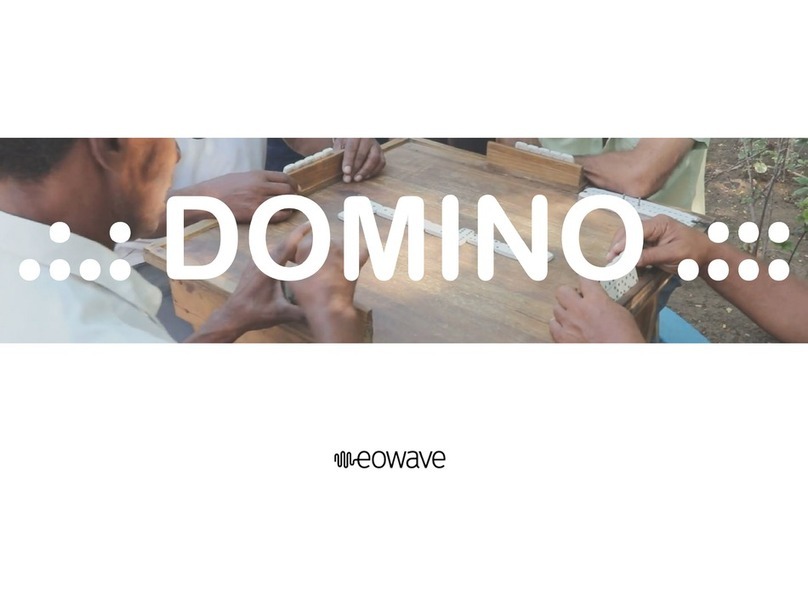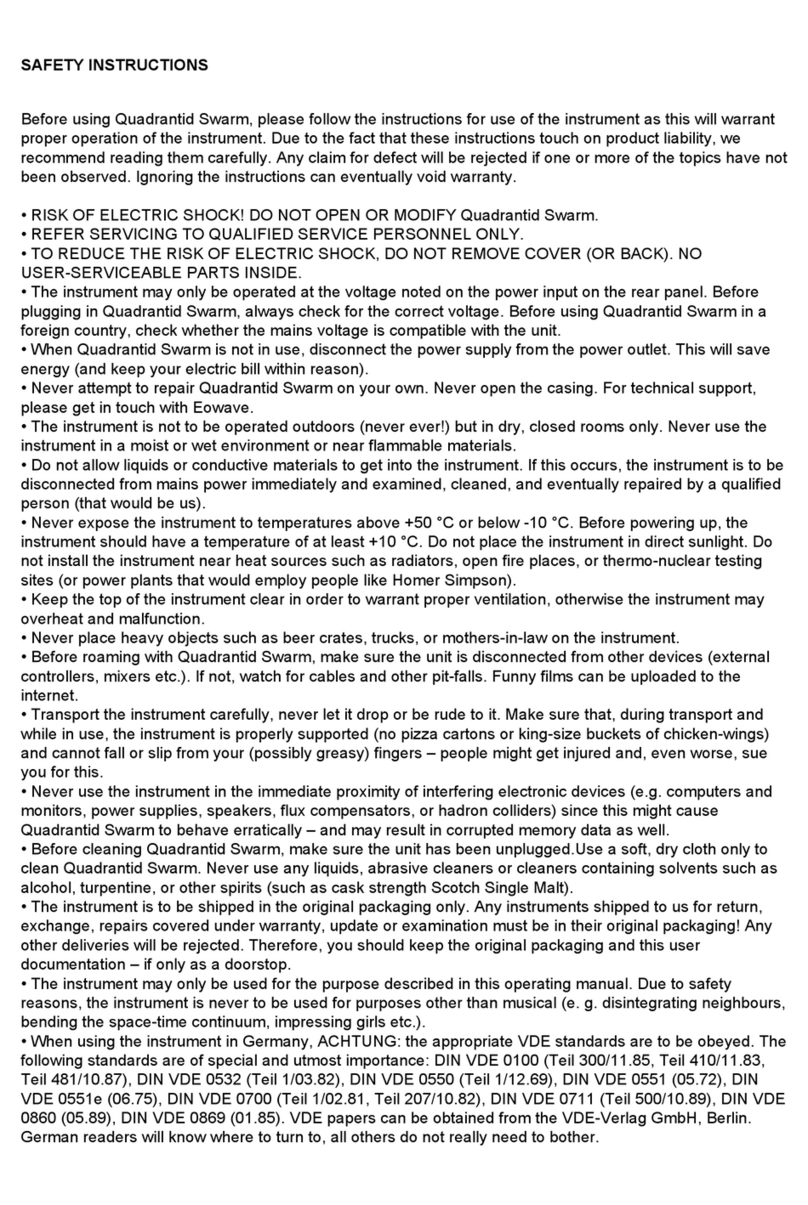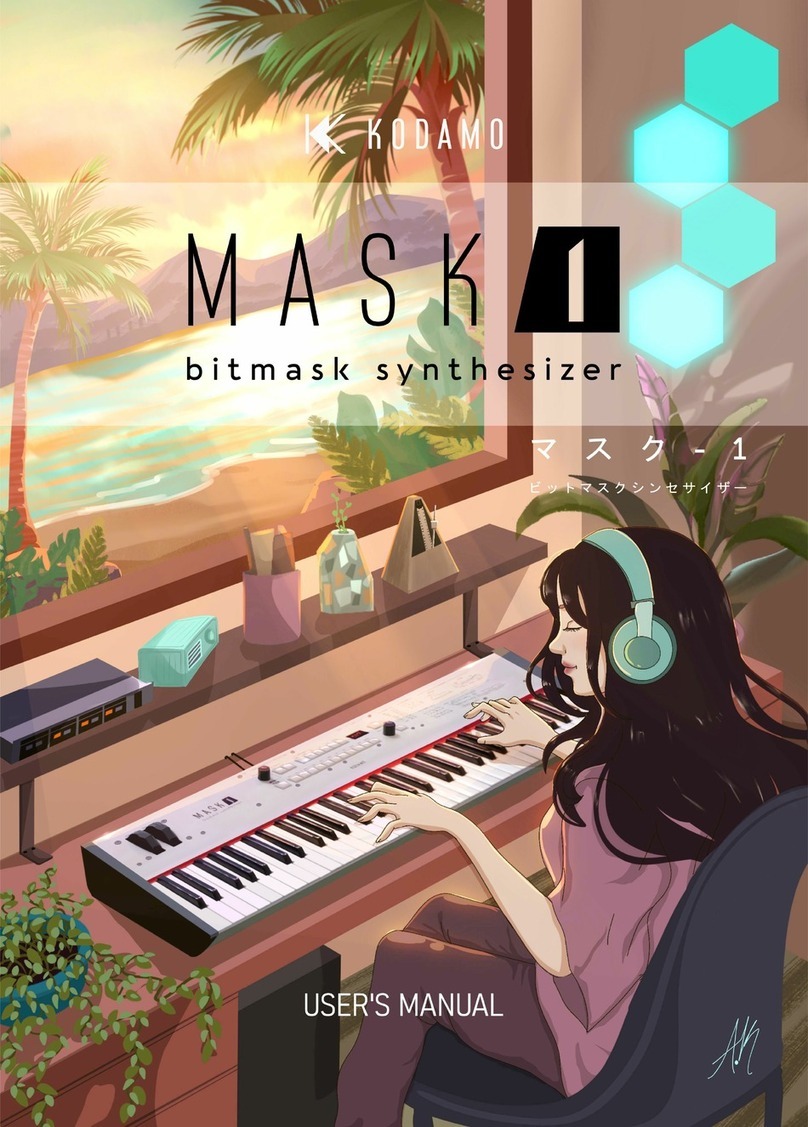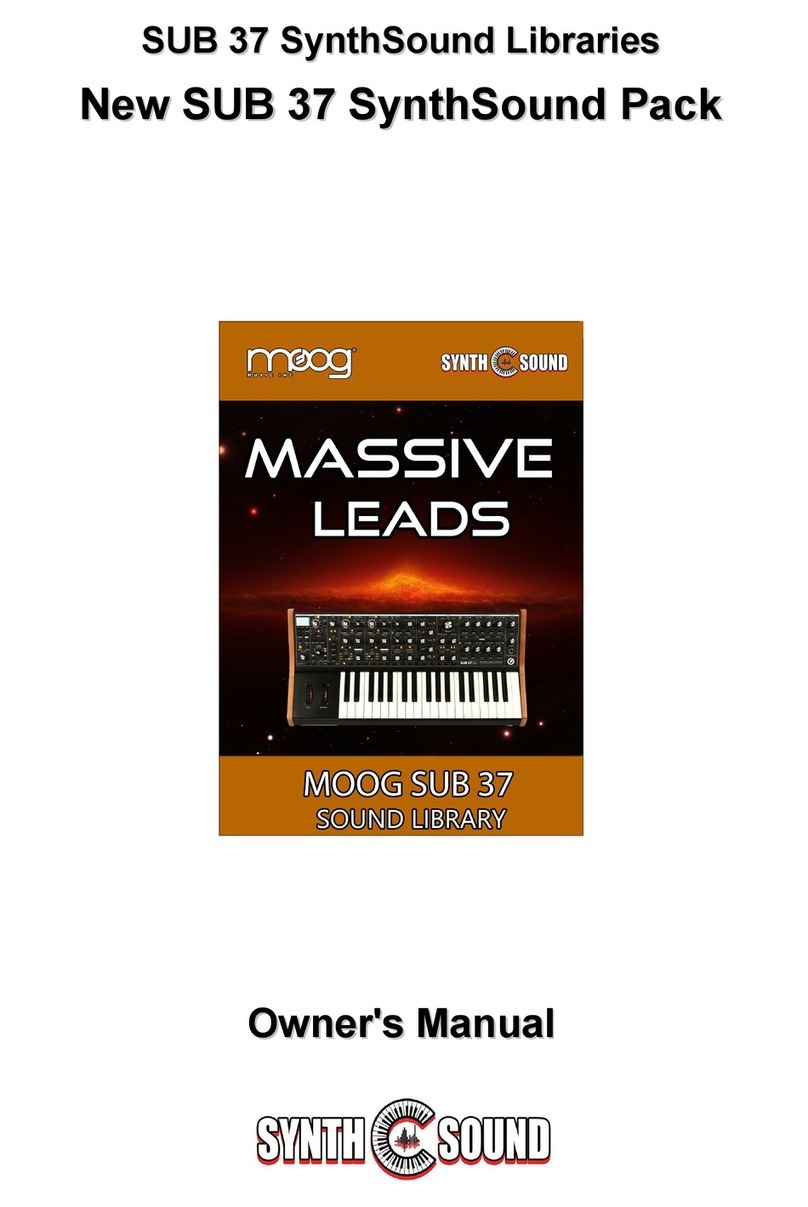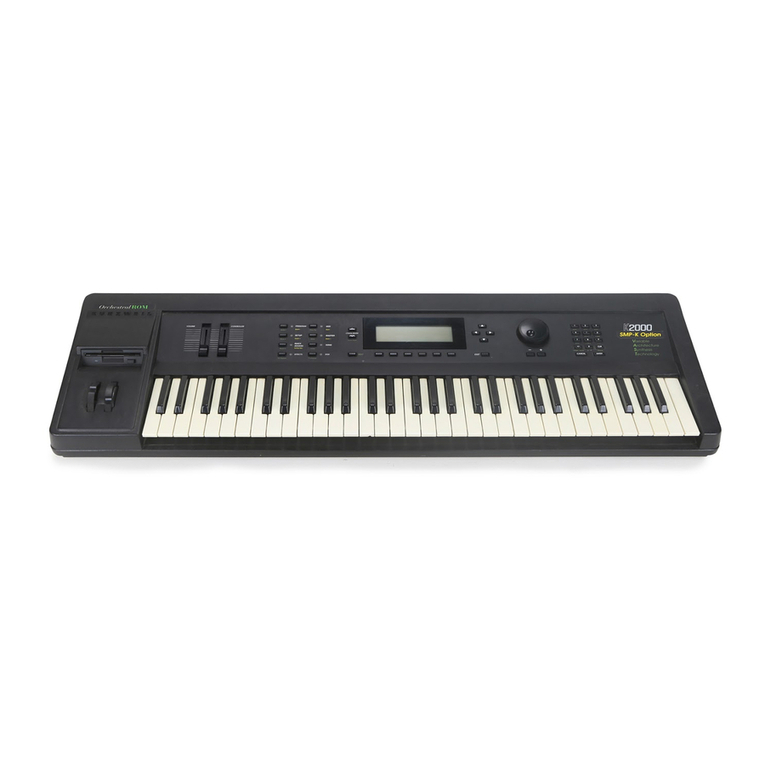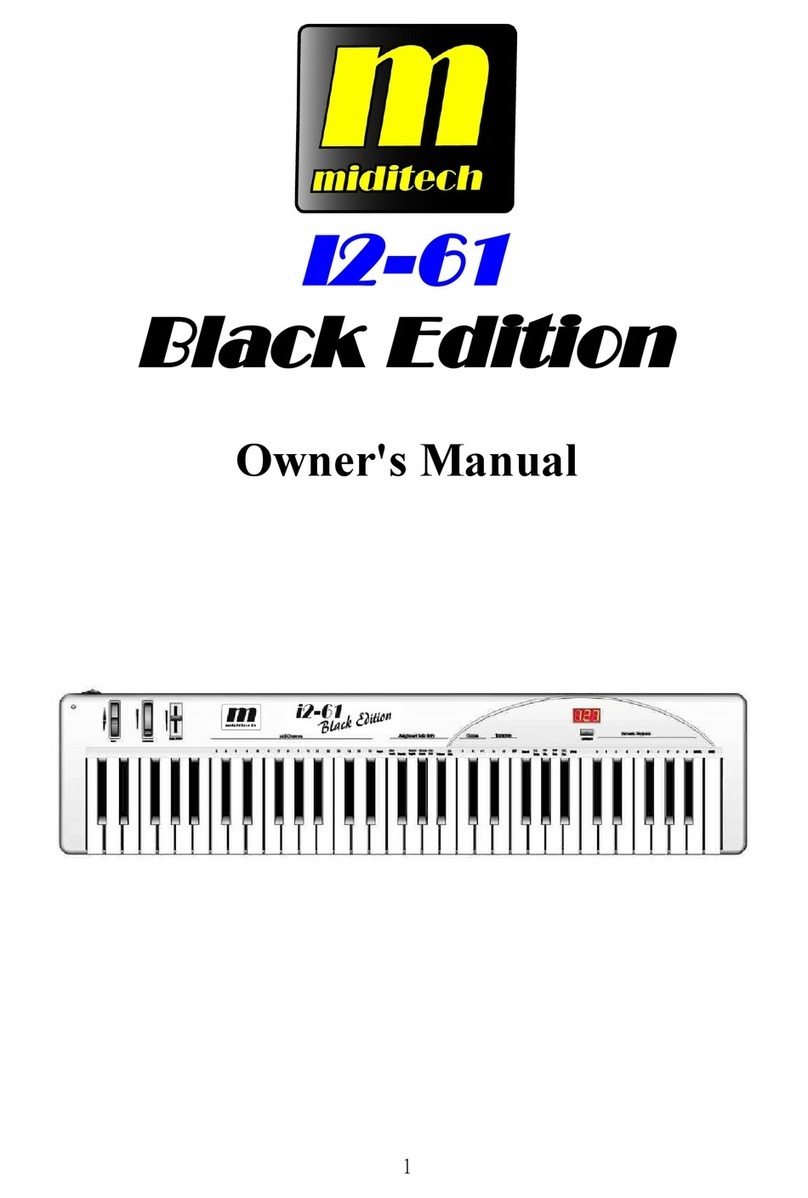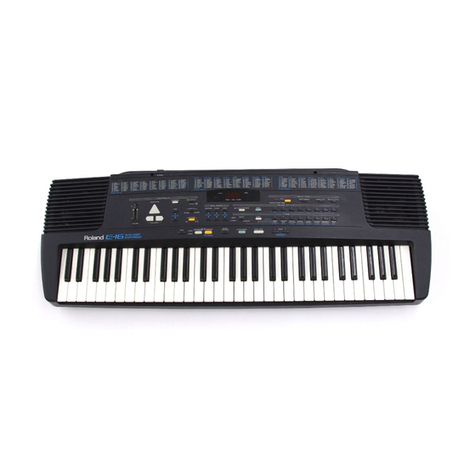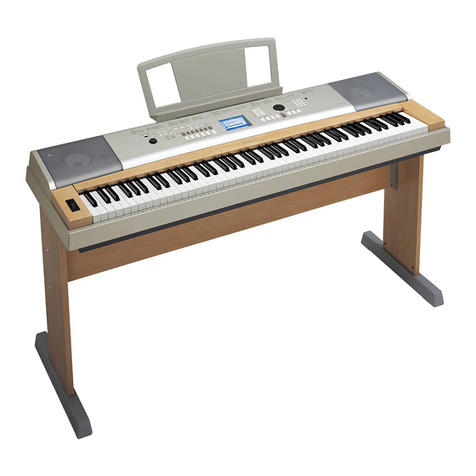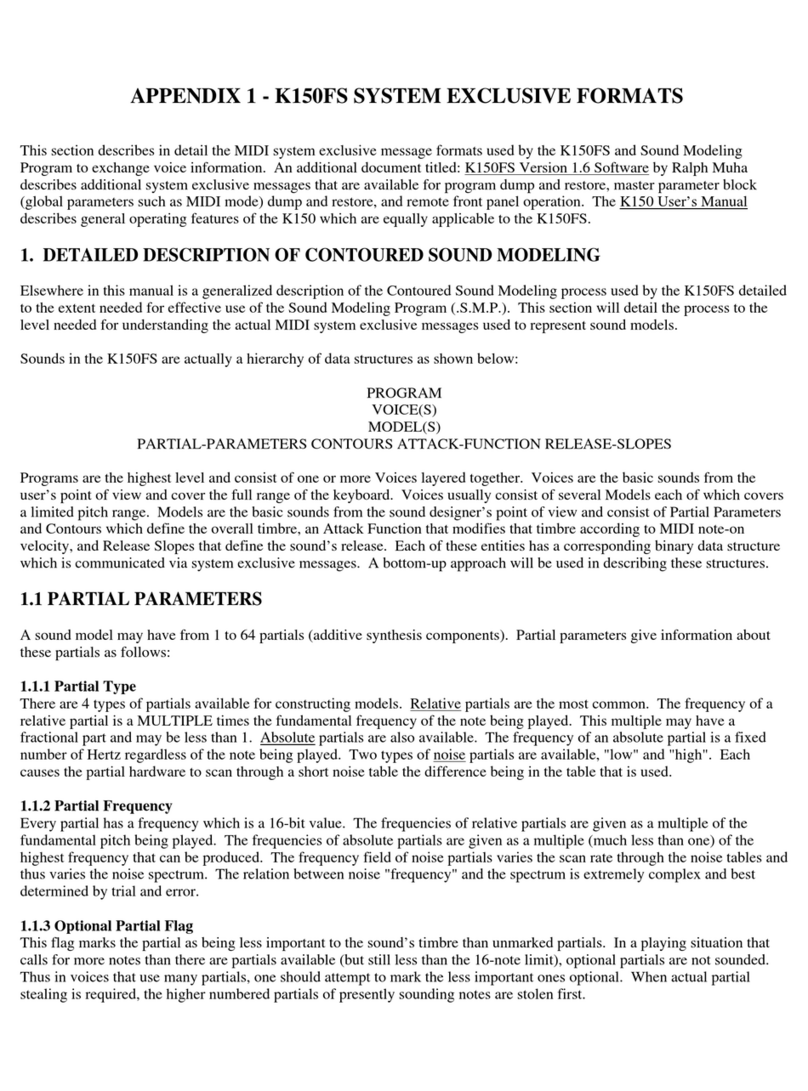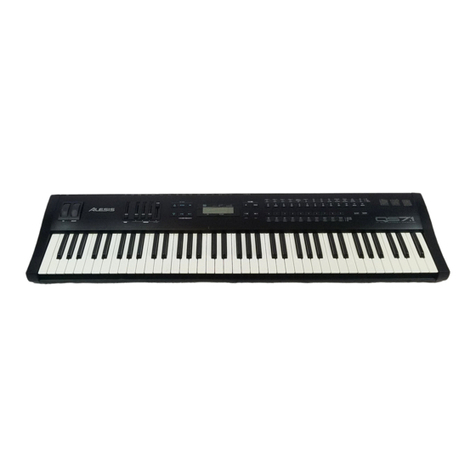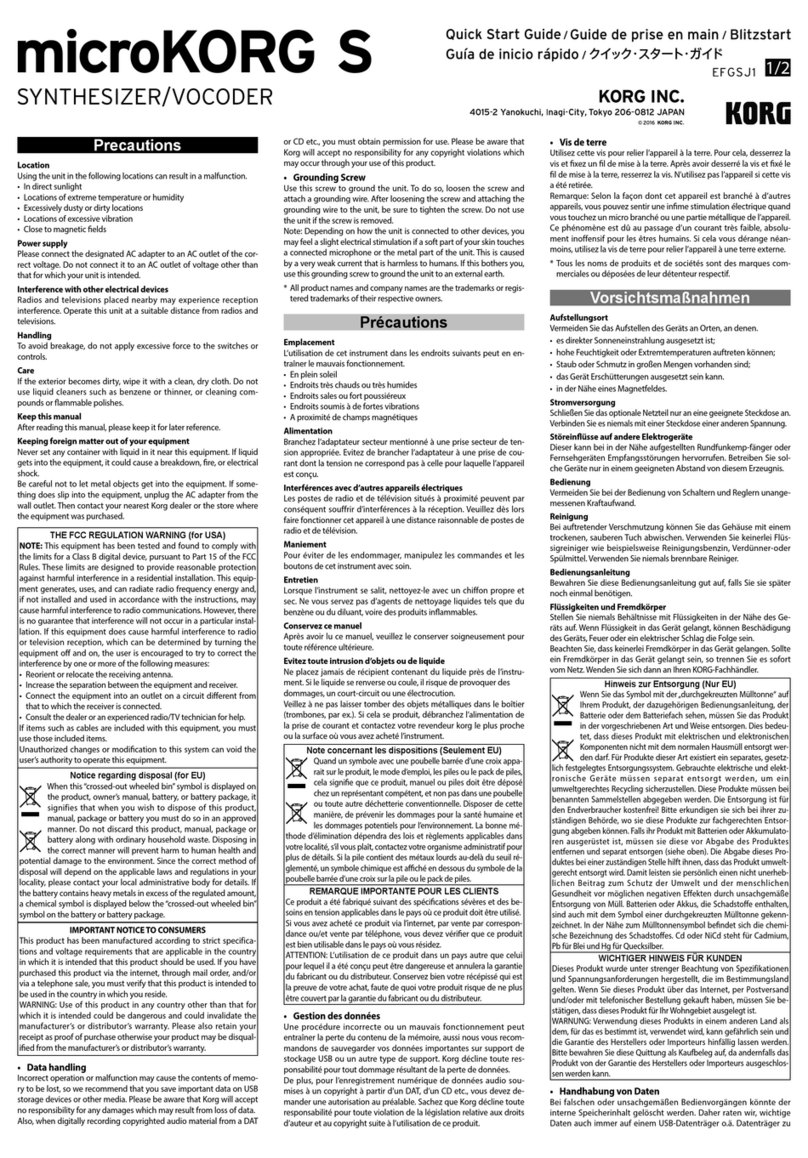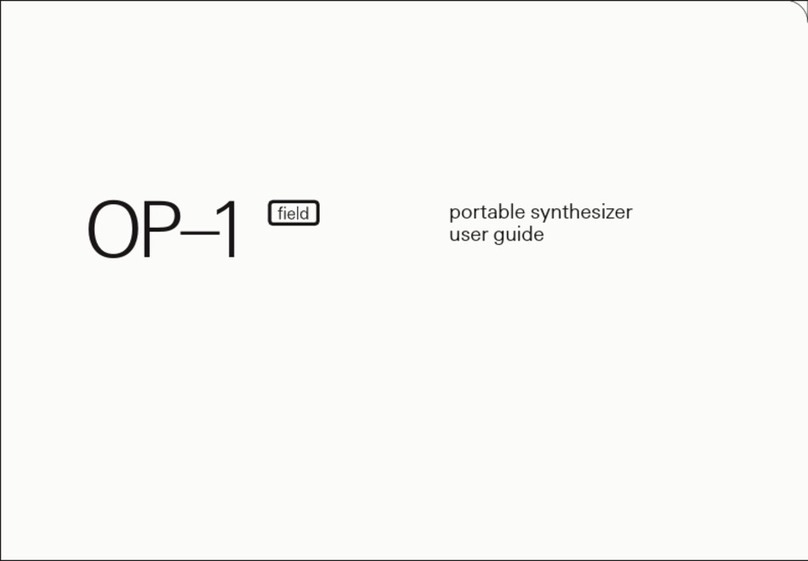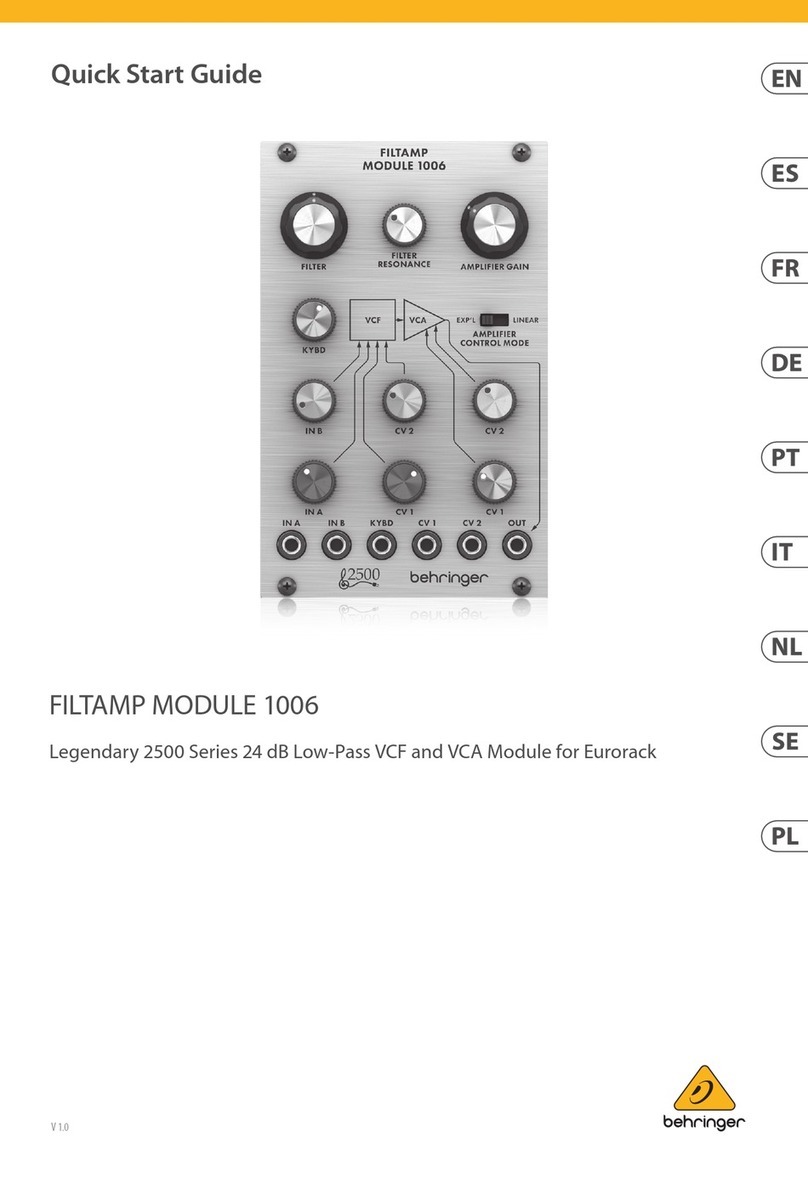Eowave Domino User manual

Connections
1/ Connect the power supply AC 12 V to the powerplug input. The
LFO LED will light up and blink.
2/ Connect the Domino audio out to your sound system (jack 6,35
mm - 1/4”).
3/ To use the Domino like an effect processor, connect the audio in
to an external sound source like another synth. it will disconnect
the internal VCO
4/ Connect the MIDI in to the MIDI out of your MIDI keyboard
or to a MIDI sequencer.
The VCO is the Voltage Controlled Oscillator, which creates continuous
waveforms from saw to square. The VCO is the sound source of the
syntheziser.
Tune: -/+ 7 semitones.
LFo section (depth + speed) >> LFO = Low Frequency Oscillator
This LFO generates 8 different waveforms. Its speed range is from 0 to 20 Hz.
It allows to modulate the VCO, the PW and the filter cutoff frequency. Play with the
corresponding amount modulation knob to modulate the sound.
Speed
When you apply a MIDI clock signal to the MIDI in port, the LFO is synced to the
midi clock signal. Unplug &replug the unit to reset to default settings. In MIDI sync
mode there are 16 different speeds available from 8 (4/4) mesures to 1/32 notes. (see
Type
The LFO has 8 different waveforms types: = Triangle, = saw,
= inverse saw, = square, = random, = noise, = staircase, = modwheel
In the 8th position the LFO is replaced by the modwheel of your keyboard
(or MIDI CC1).
VCF = Voltage Controlled Filter
The DOMINO VCF is a 24dB resonant low-pass filter.
Cutoff
The cutoff knob determines the cutoff frequency of the VCF.
In its highiest position (10), the sound will pass unchanged. As
you lower the knob, the frequencies in the higher pitch range
will be cut, fading the sound out in its lowest position (0).
Resonance
The resonance knob will emphasize the frequency at the point
set with the cutoff. As you raise the knob, certain harmonics
are boosted and the sound will be more unusual, more electro-
nic in its nature. If setting the resonance knob to the high
position and move the cutoff knob, you can obtain a type of
sound that is impossible to be reproduces by any other musical
instrument. At its highest level, self oscilation will begin (at
the cutoff frequency).
Env mod
Env mod controls how much the cutoff frequency is affected
by the envelope.
lfo mod
This controls how much the cutoff frequency is affected by
the LFO.
ENV = Envelope
The envelope generator generates the control voltage applied to the VCF
and the VCA, thereby controlling the volume and the tone color of each
note. This output voltage is generated when you press a key. The analogue
envelope range is from 1ms to 10s with attack, decay/release, sustain.
Attack
The attack knob sets the time required for the voltage to reach it’s maxi-
mum from the moment the key is pressed down.
Decay/Release
The decay knob determines the time required for the voltage to drop from
the maximum to the sustain level. When the sustain level is high, the
envelope curve does not change by adjusting the decay time. Note that the
decay also affects the time of release of the envelope.
Sustain
The sustain knob determines the sustain level to which the voltage falls at
the end of the decay time. The sustain is maintained during the gate time.
VCA = Voltage Controlled Amplifier
The VCA controls the volume (amplitude) of the sound and is controlled by the
output voltage from the envelope generator.
.:.:DOMINO.:::
Rules of the game
What is Eowave Domino?
Eowave Domino is a discrete analogue synthesizer with a VCO in the
tradition of MS20 and TB303. VCO, filter & VCA are transistor made.
Filter is a 24dB resonant filter.
Its transistor architecture gives the Domino a unique raw sound. Rich
and raw at the same time, no need of external effects to give life to
the sound. Easy to use. Direct access to all parameters. Small size and
metal enclosure. Uncompromised sounds can be obtained by mixing the
variable waveform from saw to square.
The 8 LFO variable types offer infinite modulation possibilities. Extra
additional features including a 8 steps sequencer, an arpeggiator, glide
and accent recognition widen the field of sound possibilities.
Provided with MIDI In, audio In and Out. Well, no winner, no looser, the
only rule of the game is to make cool sounds and have fun!
?
Cool tips!
Definition: What is a low-pass filter?
Filters boost and attenuate regions of a sound
spectrum. They have two essential parameters :
cutoff and resonance. A low-pass filter will let all
low frequencies go thru up to the cutoff frequency.
When the low-pass filter opens, all frequencies go
thru. When it closes, only low frequencies go thru.
See schematics a & b.
?
env/gate switch
This selector switch enables to select whether to control the VCA by
the signal from the envelope generator or by the gate signal. When
the switch is down, Gate is on. When the switch is up, envelope is on.
Glide!
Per default, the glide is activated when notes are played
legato. It can be off or continuously on.
CC2 sets the glide off/legato only/on.
CC3 sets the glide time.
The last set-up is saved in a non-volatile memory.
Accent feature!
Velocity values above 120 are recognized as an accent.
Turn the LFO into a 8 steps sequencer!!!!
On LFO modwheel position, the LFO turns into a 8 steps sequencer! In this position,
CC 9-16 modulate the intensity of each step. Plug a control surface to the Domino
MIDI IN and try this!
The envelope LED in the VCA section
shows the envelope activity. When the
switch is up, the VCA is controlled by
the envelope.
Another additional feature:
there is an arpeggiator inside!
The internal arpeggiator is be activated by MIDI CC4,
CC5 and CC6.
CC4 sets the direction: up, down, up&down or sequancial
(follows the played notes).
CC5 activates the arpegiator (off - 1 oct - 2 oct - 3 oct)
CC6 activates the latch mode (on - off). In latch mode
off, only the notes being played will be arpeggiated. In
latch mode on, any notes played are latched (memorized)
and will continue to be arpeggiated even if they are not
being played anymore.
The arpeggiator is controlled by the LFO speed and
therefore it can be synced to a midi clock.
The VCO likes it hot!!!
Allow 1/2 hour pre-heating before the
final tuning. In the first hour, the tune
will be going a couple of herz lower.
In the need for transposition
To transpose the sound more than 7 semitones, use the transpose
function of your keyboard, the internal MIDI to CV converter range
from MIDI note 12 to 108, which represents 8 octaves.
Mix: There are 2 types of wave-
forms from the VCO (saw and
square). They can be mixed to go
continuously from saw to square.
The level is a bit lower on mid
position for a cleaner sound.
Lfo mod is the LFO modulation amount of the LFO on the pitch.
Pwm is the Pulse Width modulation amount of the LFO on the pwm.
the MIDI Clock Time table on the back)
by
LFO RESET
CC20 resets the LFO at each new note that is played.
Multiple Trigger Mode
CC21 activates the Multiple Trigger Mode. In this mode, the envelope
is retriggered at each new note that is played.
Per default, the Domino is set on Single Trigger Mode.

(31-23HSRXPMOIXSFIJVMIHOnly use a AC 12V 1A power supplySVXLI
SRIWYTTPMIH
8SWXSVI]SYV(31-23YWIMXWSVMKMREPTEGOEKMRK
(SRSXSTIRSVXV]XSQSHMJ]XLIYRMXSVMXWQEMREHETXIV[LIRXLIYRMXMW
I\XIVREPP]TS[IVIH
(YVMRKPMKLXRMRKYRTPYKXLIYRMXQEOIWYVIXLIQEMREHETXIVMWRSXTPYKKIH
&IJSVIGPIERMRK]SYV(31-23QEOIWYVIXLIQEMREHETXIVERHSVER]
I\XIVREPIPIQIRXWEVIHMWGSRRIGXIHJVSQXLIYRMX'PIERMX[MXLEHV]GPSXL
(SRSXXV]XSVITEMVXLIYRMXSVXLIGSQTSRIRXWMRWMHISJMX4PIEWIGSRXEGX
IS[EZIJSVXIGLRMGEPWYTTSVXEXWEPIW$IS[EZIGSQ
(SRSXYWI]SYV(31-23RSVWXSVIMXMRHYWX]EVIEWHEQTEVIEWI\XVIQI
XIQTIVEXYVIWI\TSWIHXSHMVIGXWYRPMKLXEVIEWTVSRIXSWXVSRKZMFVEXMSRW
(SRSXMRWIVXER]SFNIGXWRSVTSYVER]PMUYMHMRXSXLIYRMX4VSXIGXXLIYRMX
EKEMRWXZMSPIRXWLSGOW
&IJSVIYWMRK(31-23MREJSVIMKRGSYRXV]QEOIWYVIXLEX]SYVQEMREHETXIV
MWGSQTEXMFPI[MXLXLIQEMRWYTTP]
2IZIVXSYGL]SYV(31-23SVMXWEHETXIV[MXL[IXLERHW[LIRMXMWTPYKKIH
MR2IZIVTPEGILIEZ]SFNIGXWSR]SYV(31-23
(31-23GERWTVIEHZIV]LMKLZIV]PS[JVIUYIRGMIW1MRH]SYVWTIEOIVW
Cautions
')RSVQ*''-2*361%8-32
-QTSVXERXRSXMGIHSRSXQSHMJ]XLMWYRMX8LMWTVSHYGX[LIRMRWXEPPIHEWMRHMGEXIH
MRXLIMRWXVYGXMSRWGSRXEMRIHMRXLMWQERYEPMWGSQTEXMFPI[MXLXLI')RSVQ*''
VIUYMVIQIRXW
-QTSVXERX;LIRGSRRIGXMRKXLMWTVSHYGXXSEGGIWWSVMIWERHSVERSXLIVTVSHYGX
YWISRP]LMKLUYEPMX]WLMIPHIHGEFPIW'EFPIWWYTTPMIH[MXLXLMWTVSHYGXQYWXFIYWIH
*SPPS[EPPMRWXEPPEXMSRMRWXVYGXMSRW*EMPYVIXSJSPPS[MRWXVYGXMSRWGSYPHZSMH]SYV*''
EYXLSVMWEXMSRXSYWIXLMWTVSHYGXMRXLI97%
2SXIXLMWTVSHYGXLEWFIIRXIWXIHERHJSYRHXSGSQTP][MXLXLIVIUYMVIQIRXWPMWXIH
MR*''6IKYPEXMSRW4EVXJSV'PEWW&HMKMXEPHIZMGIWMR8LI)YVSTIER7XERHEVH)2
SR)PIGXVSQEKRIXMG'SQTEXMFMPMX]+IRIVMGIQMWWMSRWXERHEVHSRVIWMHIRXMEP
GSQQIVGMEPERHPMKLXMRHYWXV]'SQTPMERGI[MXLXLIWIVIUYMVIQIRXWTVSZMHIWEVIEWS
REFPIPIZIPSJEWWYVERGIXLEXXLIYWISJXLMWTVSHYGXMREVIWMHIRXMEPIRZMVSRQIRX[MPP
RSXVIWYPXMRLEVQJYPMRXIVJIVIRGI[MXLSXLIVIPIGXVSRMGHIZMGIW
.:.:DOMINO.:::
Support
Contact
eowave
La Cure - 58110 Tintury - France
info@eowave.com - ph: +33/6 61 70 20 50
)PIGXVSRMG(IWMKR1EVG7MVKY]
-RXIVJEGI(IWMKR)QQERYIPPI+EPPMR
)3;%:)0-1-8)(;%66%28=ERHWXERHEVHPIKEPHMWGPEMQIV
8LERO]SYJSVTYVGLEWMRK)S[EZITVSHYGX8LIJSPPS[MRKXIVQWERHGSRHMXMSRWETTP]
;EVVERX]TIVMSHMWJSVSRI]IEVJVSQXLIHEXISJTYVGLEWI[MXLETVSSJSJTYVGLEWI
WYFQMXXIH;EVVERX]GSZIVWIPIGXVMGEPJEMPYVISJIPIGXVSRMGGSQTSRIRXWI\GITXMRGEWIW
I\TPEMRIHFIPS[3TIVEXMRKMRWXVYGXMSRWQYWXFIJSPPS[IH8LI(SQMRSQYWXRSXLEZI
FIIRHEQEKIHEWEVIWYPXSJQMWYWIRIKPIGXEGGMHIRXHIWXVYGXMSRMQTVSTIVIPIGXVMGEP
ZSPXEKIWSVGYVVIRXWVITEMVEPXIVEXMSRSVQEMRXIRERGIF]ER]TIVWSRSVTEVX]SXLIV
XLERSYVS[RWIVZMGIJEGMPMX]SVEREYXLSVM^IHWIVZMGIGIRXIVYWISJVITPEGIQIRXTEVXW
SVQSHMJMGEXMSRSJXLITVSHYGXMRER][E]3FPMKEXMSRWSJ)S[EZIWLEPPFIPMQMXIHXS
VITEMVSVVITPEGIQIRX[MXLWEQISVWMQMPEVYRMX8SSFXEMRVITEMVWYRHIVXLMW[EVVERX]
TVIWIRXXLITVSHYGXERHTVSSJSJTYVGLEWIXS)S[EZIWIVZMGIGIRXIVXVERWTSVXEXMSR
GLEVKIWTVITEMH;LIRVIXYVRMRKXLITVSHYGXJSVVITEMVTPIEWITEGOMXZIV]GEVIJYPP]
TVIJIVEFP]YWMRKXLISVMKMREPTEGOEKMRKQEXIVMEPW4PIEWIMRGPYHIERI\TPEREXSV]RSXI
Setting a new MIDI channel
7IRHMRKE4VSKVEQ'LERKIJVSQ
XS[MPPWIXXLIRI[1-(-
GLERRIP7IRH4VSKVEQ'LERKI
XSZEPMHEXIXLIRI[1-(-
GLERRIP8LMWRI[1-(-GLERRIP
MWWEZIHMRXLIMRXIVREPQIQSV]
8LI4VSKVEQ'LERKILEWXSFI
WIRXEXXLIGYVVIRX1-(-GLERRIP
-J]SYLEZIJSVKSXXIRSR[LMGL
GLERRIPXLIYRMXMWWIXXV]XS
WIRHRSXIWSREPPGLERRIPWSRI
EJXIVXLISXLIV
9WIXLMWHVE[MRKXSRSXI]SYVJEZSVMXIWIXXMRKW
MIDI Clock time table
WTIIH RSXIW
FEVW
FEVW
FEVW
FEVW
FEV
FEV
X
X
X
MIDI Implementation Chart
4MXGL&IRH LEPJXSRIW
1SHYPEXMSR[LIIP ''
+PMHI3**32PIKEXS321-(- ''
+PMXIXMQI ''
ETVHMV94(3;2
94(3;2WIUYIRXMEP ''
EVT3**3'83'83'8''
EVT0%8', ''SREFSZI
7IUYIRGIVWXITW ''''
1-(-'03'/
1-(-78%68WIX1-(-7]RG32
1-(-7834VIWIXXLI0*3
1-(-GLERRIP HIJEYPX
0*3VIWIX ''
1YPXMTPIXVMKKIVQSHI ''
,IPT-LIEVRSWSYRH
4PIEWIGLIGOXLEX]SYV(SQMRSMW
WIXSRXLIVMKLX1-(-GLERRIP
Other Eowave Synthesizer manuals
